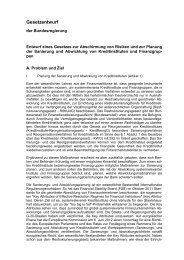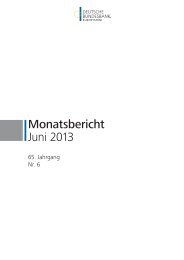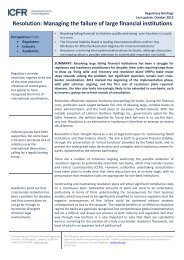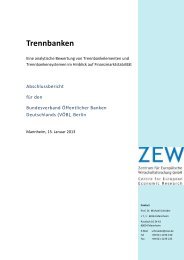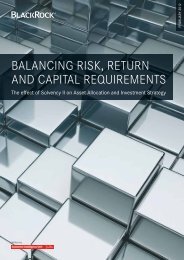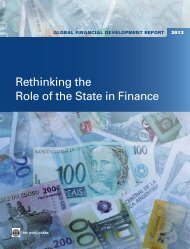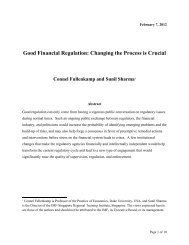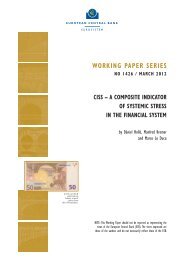3 Issuing costs of state guaranteed bonds - Financial Risk and ...
3 Issuing costs of state guaranteed bonds - Financial Risk and ...
3 Issuing costs of state guaranteed bonds - Financial Risk and ...
You also want an ePaper? Increase the reach of your titles
YUMPU automatically turns print PDFs into web optimized ePapers that Google loves.
3 <strong>Issuing</strong> <strong>costs</strong> <strong>of</strong> <strong>state</strong> <strong>guaranteed</strong> <strong>bonds</strong><br />
To account for this possibility, country dummies were added to the main empirical specification.<br />
However, the previously reported average estimated impact <strong>of</strong> <strong>state</strong> guarantees on issuing cost is<br />
robust to this change.<br />
A third hypothesis is that differences in bond clauses actually account for differences in issuing<br />
cost across non-SG <strong>and</strong> SG <strong>bonds</strong>. In an earlier section, for example, it was noted that the presence<br />
<strong>of</strong> a negative pledge clause (reducing credit risk for investors) is likely to be reflected in a lower<br />
issuing cost. If SG <strong>bonds</strong> contain a disproportionate amount <strong>of</strong> negative pledge clauses, these may<br />
show up as the impact <strong>of</strong> <strong>state</strong> guarantees when they are not.<br />
To account for this, bond clauses were added as controls to the main empirical specification <strong>and</strong>,<br />
as with country dummies, the main result on the impact <strong>of</strong> <strong>state</strong> guarantees is robust to this<br />
change.<br />
3.5.9 Sensitivity <strong>of</strong> empirical strategy<br />
Our main empirical specification used the population <strong>of</strong> eligible banks <strong>and</strong> non-SG <strong>bonds</strong> as the<br />
control group for measuring the impact <strong>of</strong> <strong>state</strong> guarantees on issuing cost. This is reasonable as<br />
long as the controls chosen sufficiently capture differences in issuing <strong>costs</strong> not accounted for by<br />
<strong>state</strong> guarantees.<br />
However, there remains the concern that unobservable differences between SG <strong>and</strong> non-SG <strong>bonds</strong><br />
are driving the main results.<br />
Alternative weights for SG <strong>and</strong> non-SG <strong>bonds</strong> were used to test for the sensitivity <strong>of</strong> our empirical<br />
strategy to unobservables <strong>and</strong> as shown in columns 10-12 <strong>of</strong> Table 9.<br />
Two control groups were constructed to control for unobserved time- <strong>and</strong> Member-State-specific<br />
factors, which includes specificities in bond market conditions, other public support measures,<br />
short-term funding <strong>and</strong> central bank measures.<br />
Practically, non-SG <strong>bonds</strong> issued at the same time <strong>and</strong>/or relating to the same country <strong>of</strong> risk as SG<br />
<strong>bonds</strong> were given more weight in the analysis as they were viewed to share greater similarlities<br />
than other non-SG <strong>bonds</strong>.<br />
Qualitatively, the main result holds across all three alternative weights specified. That is, <strong>state</strong><br />
guarantees reduce issuing cost to a statistically significant degree whether non-SG <strong>bonds</strong> issued at<br />
the same time as SG <strong>bonds</strong> are emphasised in the control group <strong>and</strong>/or non-SG <strong>bonds</strong> relating to<br />
the same country <strong>of</strong> risk are emphasised in the control group.<br />
Quantitatively, the average impact <strong>of</strong> a <strong>state</strong> guarantee is in the region <strong>of</strong> 45-55bps reduction in Zspread<br />
based on two <strong>of</strong> the alternative weighting schemes. This is in the region <strong>of</strong> the majority <strong>of</strong><br />
other alternative specifications considered.<br />
However, the comparison <strong>of</strong> SG <strong>and</strong> non-SG <strong>bonds</strong> relating to the same country <strong>of</strong> risk suggests<br />
that the average impact <strong>of</strong> a <strong>state</strong> guarantee on reducing issuing cost is 18bps (column 11 in Table<br />
9). This is interesting because it suggests that <strong>state</strong> guarantees are more effective in some<br />
Member States than others even accounting for differences in sovereign risk (reflected through<br />
the sovereign CDS) <strong>and</strong> country risk controls.<br />
65



